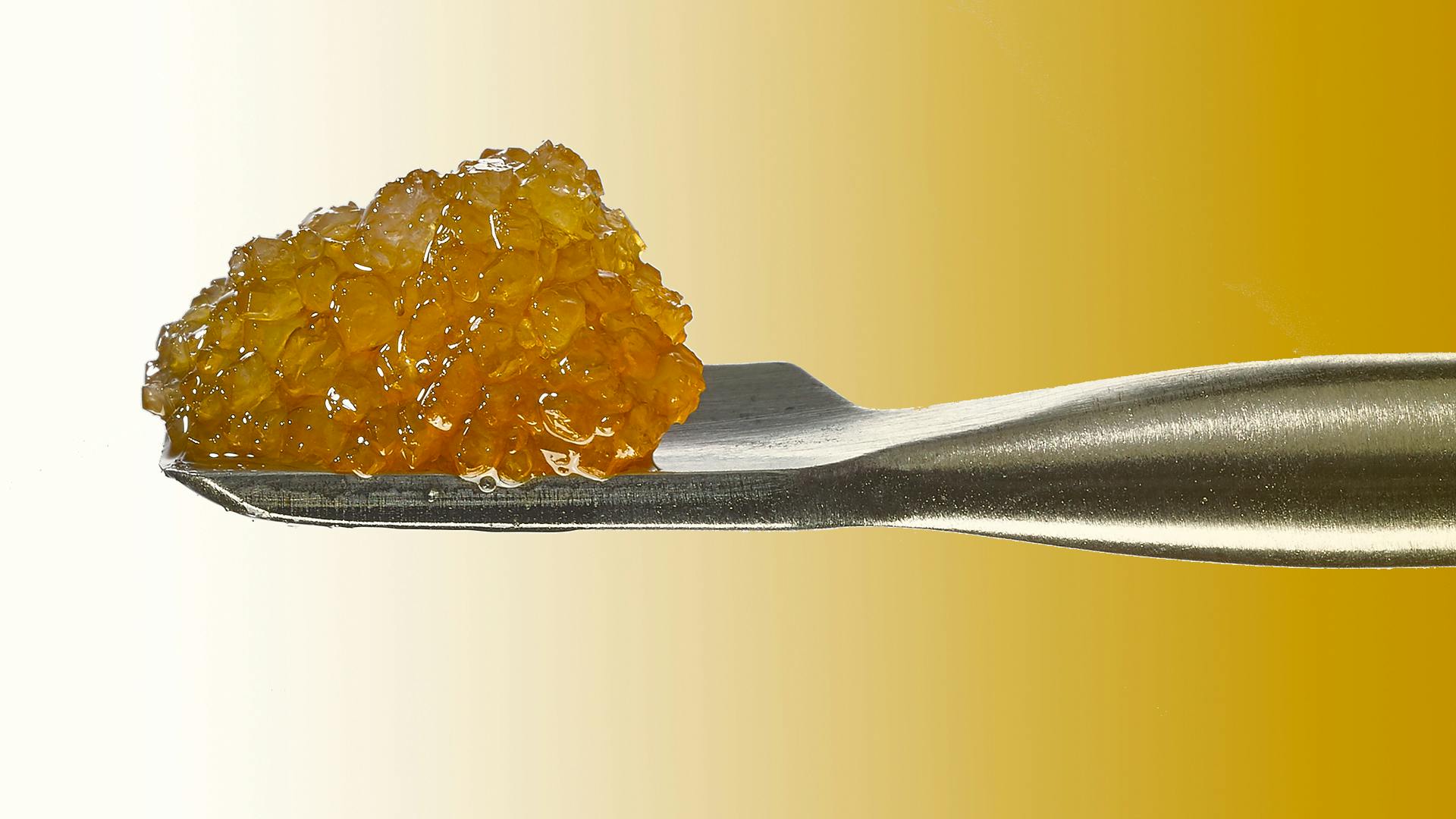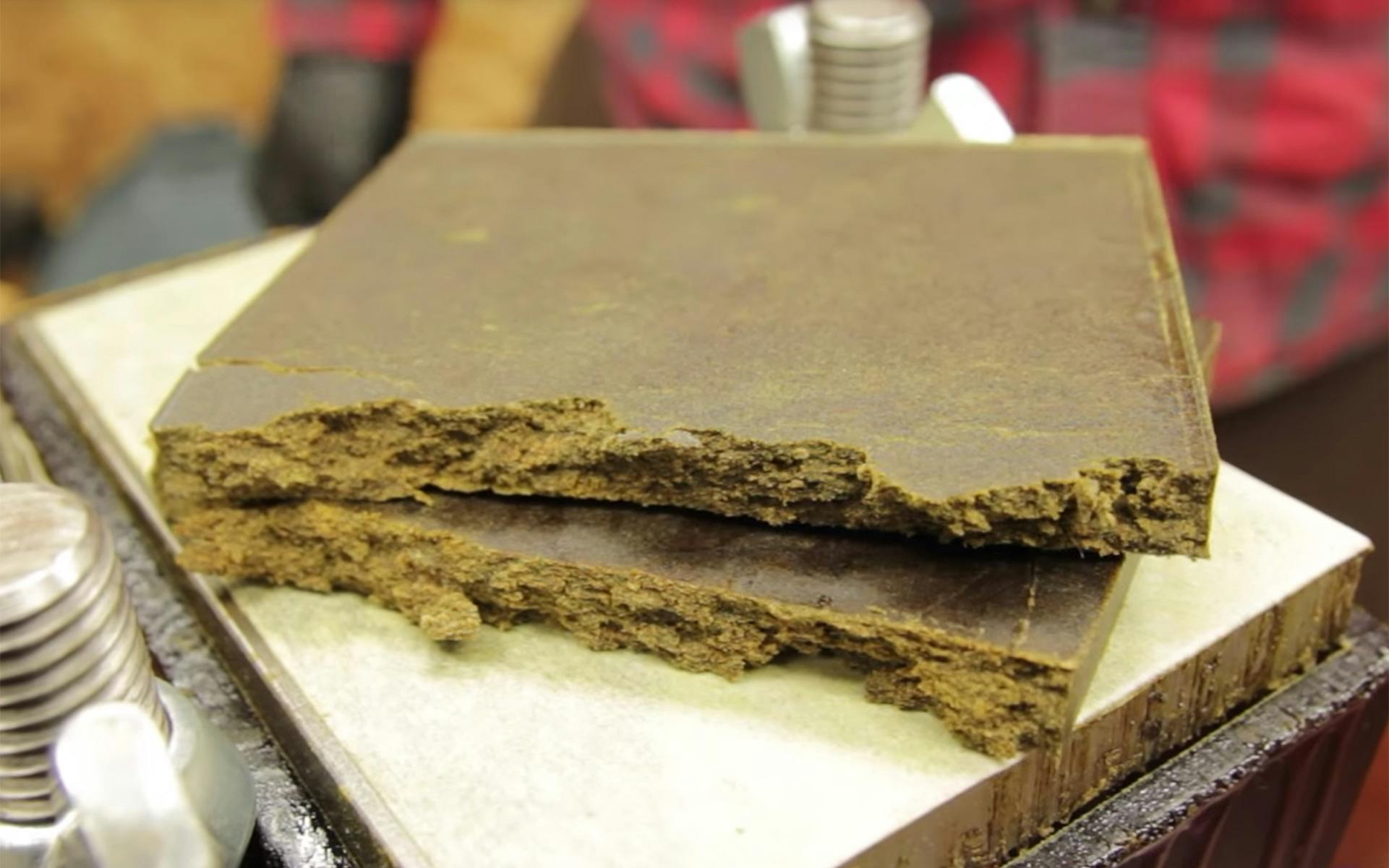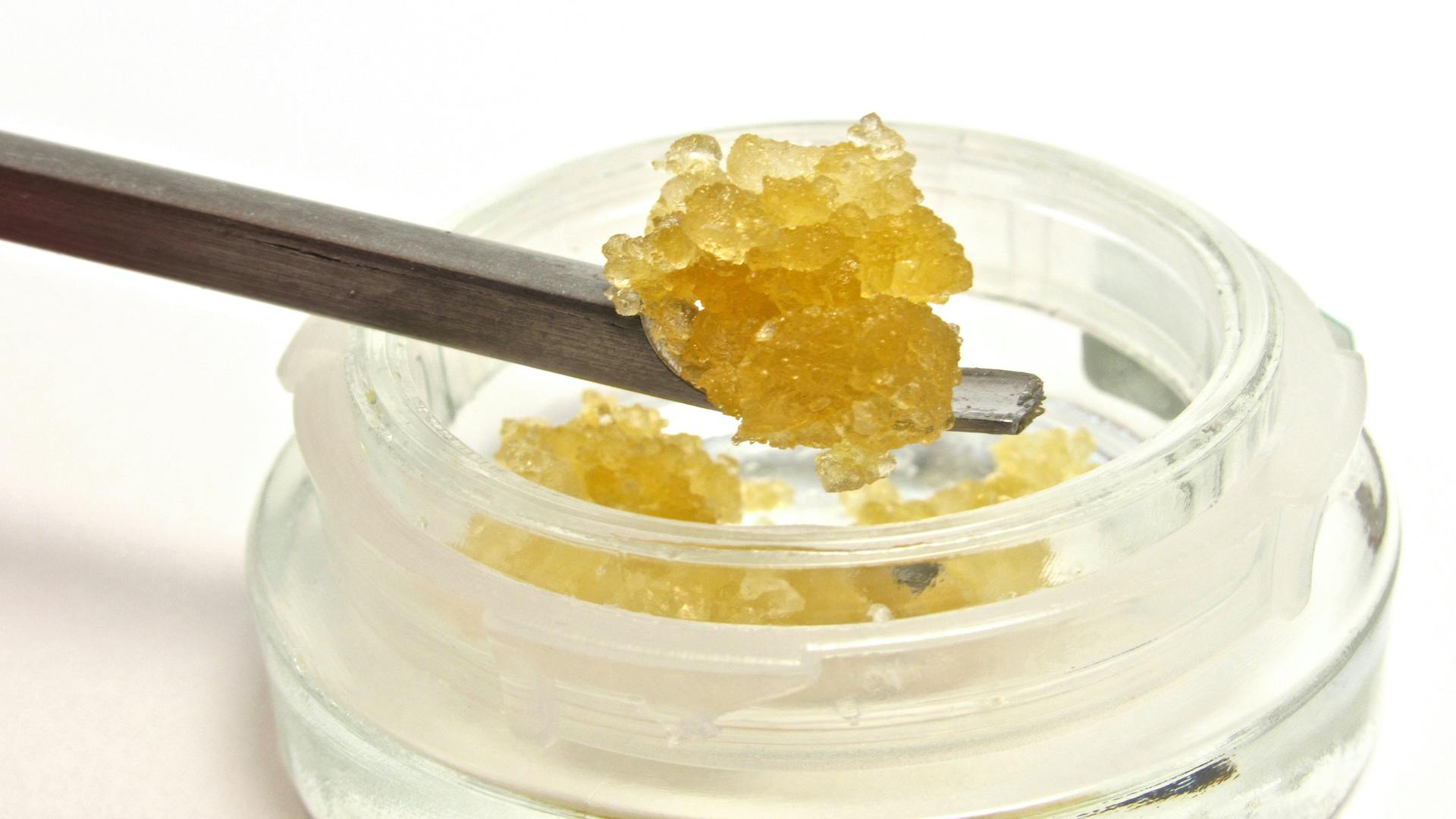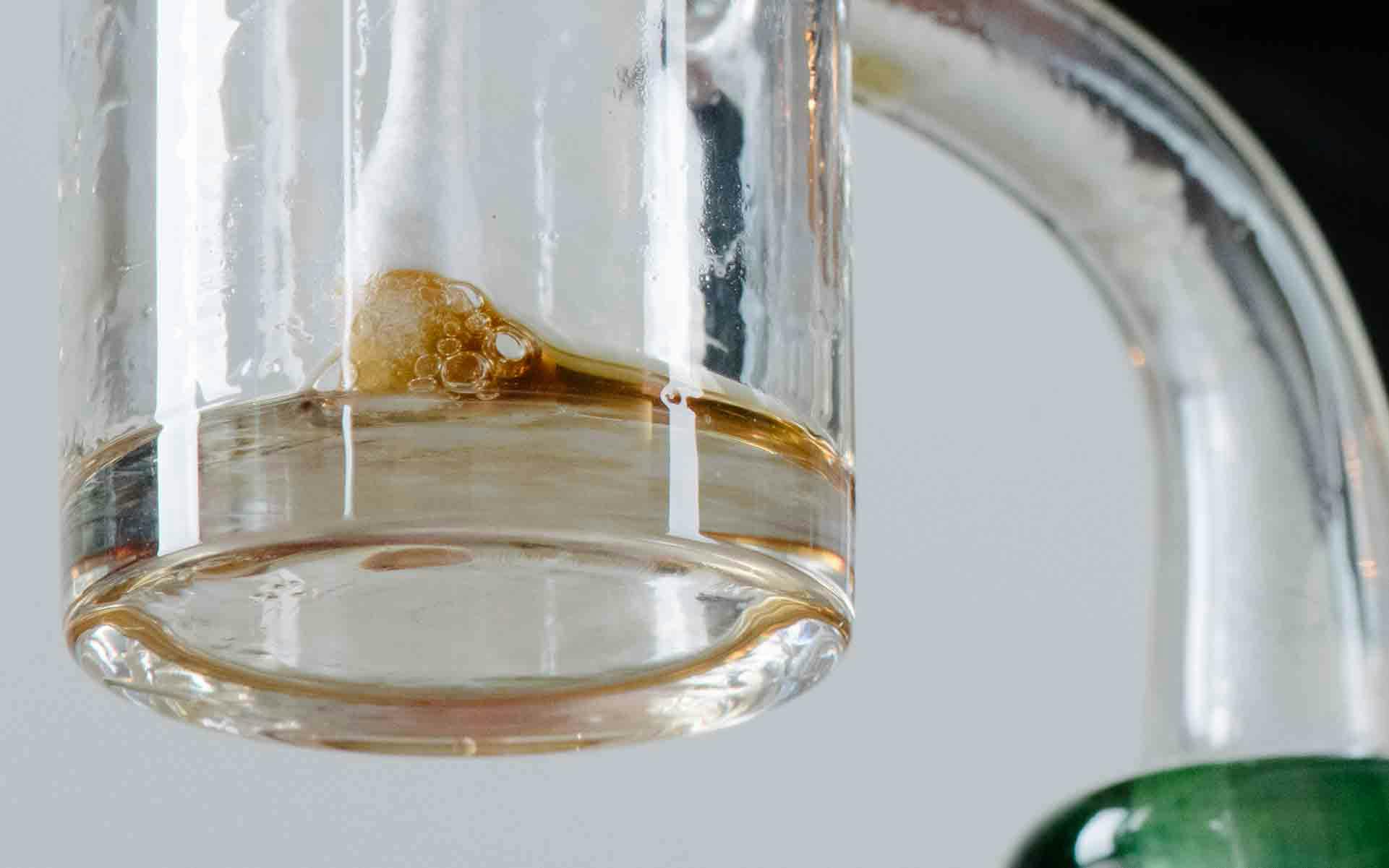
Rosin is a cannabis concentrate that is solventless—it’s not made with any solvents or chemicals. Relying on heat and pressure to extract cannabis compounds, rosin is considered a cleaner extract, but it’ll cost you: Rosin is typically more expensive than concentrates made with solvents.
Learn more about how to consume rosin, and how you can make it at home, below.
What is rosin?

By definition, rosin is a cannabis extract made using heat and pressure—cannabis plant material is placed in a press with heated pads and then compressed, squeezing out hot oil. The process is solventless, so no solvents or chemicals are used in creating rosin. This process was originally used to create rosin for violin bows, which is how the concentrate gets its name.
Rosin is ready in minutes and doesn’t require any extra steps to purify or dilute the extracted oil. Making it is simple, and anyone can make rosin at home with a DIY rosin press or a few household tools (more below).
Rosin is considered to be a dab, as it is most often consumed in a dab rig. However, it can also be put in a cartridge and vaped. Rosin is not considered a wax, as waxes are made with solvents such as butane.
Why is rosin so popular?
People love rosin because it is more flavorful than other cannabis concentrates and because no chemicals or solvents are used in the creation of it. The taste is cleaner, more pure, and more terpy. Compared to other extracts, it is typically less potent, but it depends on the source material used to make it.
Another great thing about rosin is that you can make it yourself at home, either with some household tools or a rosin press, giving you fresh extract on-demand.
What is rosin made from?
Rosin can be made out of a variety of types of cannabis, including:
- Nugs or flower
- Trim
- Kief
- Hash
The higher the quality of the input material, the higher the quality of the rosin. People who consume rosin are usually looking for flavor in their dabs and will often use flower or nugs to press it, which is the highest quality starting material.
Rosin can also be made from trim, kief, or hash, and is great to make if you have a surplus of any of those. Pressing trim, kief, or hash into rosin will refine them, although the final product won’t be as high of a quality as starting with flower or nugs.
Is rosin full-spectrum?
Many cannabis extractions are further refined to remove other compounds, but rosin is a full-spectrum extract, containing the cannabinoid and terpene profile of the original plant.
Types of rosin
Different types of rosin include:
- Flower rosin—uses dried nugs, mids, shake or trim; most common source material for rosin, and more flavorful than hash rosin
- Live rosin—uses frozen weed plants; more flavorful than other rosins as using frozen plants preserves terpenes and flavors
- Hash rosin—uses bubble hash or dry sift hash; generally harsher than flower rosin as hash is harsher, and can be more potent depending on the hash used
Does rosin make you more high than other types of weed?
Generally speaking, rosin is usually less potent than cannabis concentrates made using solvents, such as shatter, but it depends on the starting material used. Rosin is usually more flavorful than solvent concentrates because the process of making rosin preserves terpenes more.
As a concentrate, rosin is more potent than flower.
What to look for in high-quality rosin
Rosin should be golden yellow to dark yellow in color. Generally, the lighter the rosin, the higher the quality. When freshly pressed, it will be hot and drippy like an oil. When it cools, it will be soft and creamy or honey-like, and malleable.
Fresh, high quality source material will translate to high quality rosin. Pressing at low temperatures—below 250°F—will keep terpenes intact and preserve flavor.
How to use rosin
Making rosin can be a great way to refine and purify low-grade cannabis such as trim or low-grade hash. It’s also great if you have a lot of cannabis, such as if you’re growing your own.
Rosin is dabbed like other concentrates, in a dab rig, e-rig, or dab pen, and it is typically done at a low temperature. Rosin doesn’t need as much heat as other dabs, and low temperatures will preserve its terpene profile and flavor.
Some people also dry out rosin and sprinkle it onto a bowl or in a joint for an added kick.
Rosin vs. resin: What’s the difference?
Many confuse “rosin” and “resin” because the two terms sound so similar. Broadly speaking, resin is the sticky substance secreted by trichomes on marijuana plants. If you smoke enough flower in a pipe or bong, there will be a buildup of resin in it.
Resin can also be a type of concentrate extracted from cannabis through a solvent extraction method, involving chemicals such as butane, propane, and others, in a closed-loop extraction system.
As we’ve mentioned above, rosin is solventless—it is extracted through heat and pressure, without any chemicals. Both resin and rosin are made from dried cannabis material.
These extracts can be complicated further with the terms “live resin” and “live rosin”—the “live” simply means that frozen cannabis plants were used to produce them instead of dried flower.
The process for making rosin is typically more labor-intensive and costly, so rosins tend to be more expensive than resins. Because rosins are solventless, they are thought to be cleaner because they don’t use chemicals.
As resins require solvents and a closed-loop system, they should only be created by licensed professionals in a certified lab and only bought in a legal market that requires products be tested.
Rosin vs. BHO vs. shatter
Rosin is a solventless concentrate created through heat and pressure. BHO, short for “butane hash oil,” is an umbrella term for solvent concentrates—those made with a solvent, or chemical, such as butane.
Rosin is considered to be a cleaner concentrate because it doesn’t use chemicals. All BHO concentrates must be purged of their chemicals and can only have a certain level of residual solvents in order to pass testing and be sold in a legal market. However, some consumers still prefer rosin because making it doesn’t involve chemicals at all.
Rosin is typically more expensive than BHO because the process to make it is more time- and labor-intensive; it’s considered a craft or artisanal concentrate.
Shatter is a common type of BHO concentrate that is hard, brittle, and glass-like in texture. Fresh rosin out of a press is liquidy; when it dries, it has a soft consistency that is more malleable than shatter.
How to make DIY solventless rosin
There are a few ways you can press flower, hash, or kief to make your own rosin. You can buy a small DIY rosin press for your home, which are easy to use but expensive, or simply use a hair straightener, which is trickier to use but much cheaper.
How to use a rosin (or dab) press
DIY rosin presses like the Rosinbomb or Nugsmasher allow you to easily make rosin at home—simply turn it on and let it warm up, place some nugs in parchment paper in between its heated plates, and watch them squeeze rosin out of the bud. The whole process only takes a few minutes, giving you fresh rosin whenever you want.
To see a rosin press in action, check out the video above, which shows a commercial press. DIY rosin presses are similar but smaller.
The downside to these devices is that they are expensive—they usually start at $400-500, and go up from there. DIY rosin presses are usually for rosin connoisseurs.
Types of rosin presses
- Manual—the most inexpensive type of rosin press, you have to use your hands and hold the pressure to get press rosin.
- Hydraulic—technically also a manual press, these use a hydraulic system operated by a hand, foot, or electric pump to press rosin.
- Pneumatic—these use compressed air to press rosin; they are usually expensive and can take up a lot of space. but can press a lot of rosin over a long period of time.
- Electric—easy to use and small, these presses plug into the wall and rely on electric power to press rosin.
How to press rosin with a hair straightener
You can also safely and inexpensively make rosin at home in a few minutes with some ordinary household tools, mainly, a hair straightener.
When pressing cannabis plant material, a hot light yellow or amber oil will ooze out. Be careful, it’ll be sticky! Be sure to give yourself plenty of space, and watch that the oil doesn’t get all over the place.
Additionally, use caution when pressing rosin because the press will be hot.
Rosin can be made with cannabis flower, kief, or hash. The higher the quality of starting material, the higher the quality of the pressed rosin. Pressing kief or trim won’t get you as great a rosin as pressing top-shelf nugs.
Tools to press DIY rosin

- Cannabis, either flower, kief, or hash
- Hair straightener, with a setting of 300°F or lower—higher temperatures can ruin terpenes and flavor
- Parchment paper, preferably unbleached
- Collection tool, such as a dab tool
- Heat-resistant gloves, for safety
How to press rosin step by step
- Set hair straightener to lowest setting, under 300°F
- Cut out a small 4×4” piece of parchment paper and fold it in half
- Place cannabis in the folded parchment paper
- Position the hair straightener around the cannabis material in the parchment paper, making sure all material is between the hot irons
- Apply firm pressure for 3-7 seconds; you should hear a sizzle before releasing pressure, which indicates oil has melted off the cannabis
- Remove and unfold the parchment paper
- Using a dab tool or other device, discard the flattened cannabis and pick out and discard any additional pieces
- Either dab the rosin right away, or scrape it into a container, such as an airtight glass jar, for storage
How to fold parchment paper when pressing rosin

It’s important to always use parchment paper when pressing rosin. Not using wax paper will get hot, sticky rosin all over your press and be messy to clean up, and potentially dangerous if it’s hot.
When pressing hash or kief into rosin, we recommend using a method called directional flow, or directional fold, which is a way of folding parchment paper when making rosin to get a clean, consistent press.
Directional flow does not need to be used when pressing flower, as the rosin created will be minimal—simply folding nugs in wax paper will do. When hash or kief is pressed, the amount of rosin created is much more substantial.
To use directional flow, fold wax paper like an envelope around the kief or hash you’re pressing, so that the wax paper is folded on three sides and open on one side. This folding will direct the flow of rosin out the open side when pressing for easy collection.
How many rosin dabs will I get?
When pressing rosin, you’ll get a lot less rosin compared to how much cannabis you started with, but each dab of rosin will be much more potent.
For example, if you press a nug about the size of a gram, expect to get only a handful of dabs worth of rosin from it. That same nug might get you 3-4 bowls of flower with several hits, but when pressed into rosin, only about 4-5 dabs.
Patrick Bennet contributed to this article.
Edited by Pat Goggins
By providing us with your email address, you agree to Leafly's Terms of Service and Privacy Policy.



